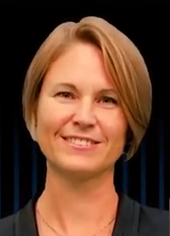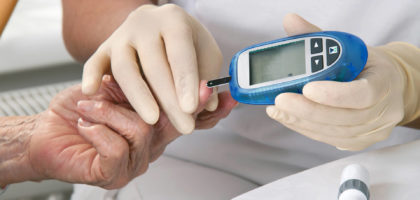Unser Experte für Gebärmutterhalskrebs
Prof. Dr. med. Sara Yvonne Brucker

Institution and position: Medical Director of the Research Institute for Women’s Health at the University Hospital Tübingen and Stellv. Director of the Department of Women’s Health at the University Hospital Ulm. Chairholder (W3) for Special Gynecology and Women’s Health at the Eberhard-Karls-University Tübingen.
As of: 14.03.2018
Die Mitschrift des Interviews mit Prof. Dr. med. Sara Yvonne Brucker zum Thema “Gebärmutterhalskrebs”
Wie gefährlich ist der Gebärmutterkrebs?
Cervical cancer is not the same as uterine cancer and that is very important. You have to tell if the cancer is in the uterine cavity, for example, or if it is sitting on the cervix. Generally, regardless of localization, uterine cancer is a cancer that is often detected very early, and therefore the chances of recovery are very, very high. We can usually cure such patients with a single therapy.
Gibt es Risikofaktoren für den Gebärmutterkrebs? Die Antibabypille?
There are risk factors for uterine cancer and again there is the distinction: is it a Krens of the cervix or the uterine cavity. It is now known that cervix cancer is mainly caused by viruses called human papillomaviruses. These are viruses that are transmitted mainly during intercourse, but just now there is a vaccine, a proper prevention against cancer. Looking at the uterine cancer, the contraceptive pill in the sense does not have the effect as a risk factor. However, one has to keep in mind that in summary, if a patient is overweight, for example, or if she has diabetes or hypertension, then she is more likely to be one of the women,
Besteht nach den Wechseljahren ein besonderes Krebsrisiko?
Generell gilt, dass beim Gebärmutterkrebs, egal ob Gebärmutterhöhlenkrebs oder Gebärmutterhalskrebs, die Wechseljahre eher zur Frühentdeckung beitragen. Der Vorteil der Wechseljahre, und in dem Fall kann man tatsächlich von Vorteil bei den Wechseljahren sprechen, ist, dass wenn in den Wechseljahren eine Blutung auftritt, die dann eben als postmenopausale Blutung bezeichnet wird, dass das ein sehr frühes Zeichen für eine mögliche Gebärmutterkörperkrebs-Erkrankung ist. Das heißt, Gebärmutterkrebs der in den Wechseljahren oder danach auftritt, ist ein Krebs der in einem ganz, ganz frühen Stadium erkannt wird, eben durch dieses erste Zeichen der sogenannten PMB, das heißt einer postmenopausalen Blutung.
Was kann ich selber tun, um das Krebsrisiko zu senken?
Gerade beim Gebärmutterkrebs haben wir eine sehr gute Präventionsmöglichkeit, das heißt eine sehr gute Strategie, um tatsächlich Krebs zu verhindern, denn wir wissen, dass der Gebärmutterhalskrebs zu 98% durch die sogenannten humanen Papillomaviren ausgelöst wird. Diese Viren kommen bei geschlechtsaktiven Frauen in der Bevölkerung bei einem überwiegenden Anteil immer wieder vor und normalerweise bekämpft der Körper diese Viren. Wenn er diese aber über viele Jahre hinweg nicht erfolgreich beseitigt, dann entsteht durch die fortlaufende örtliche immunologische Auseinandersetzung mit dem Gewebe irgendwann Gebärmutterhalskrebs. Um diese Viren erst gar nicht dazu zu bringen, dass sie die Zellen verändern, gibt es seit einigen Jahren die sogenannte HPV-Impfung, nämlich die Impfung zur Verhütung einer Infektion mit diesen Viren, und damit zur Verhinderung der Entstehung von Gebärmutterkrebs.
Auf welche Symptome sollte die Frau achten?
Das Gute beim Gebärmutterkrebs ist, dass es normalerweise eine Krebsart ist, die wir schon in einem sehr frühen Stadium, normalerweise sogar schon bei Vorstufen entdecken können. Und hier ist es ganz wichtig und das erzähle ich auch immer meinen Patientinnen, und bitte erzählen Sie das auch ihren Töchtern, gehen Sie regelmäßig zur Vorsorge. Nehmen sie bei den niedergelassenen Kollegen einmal im Jahr die Vorsorgeuntersuchung, den Krebsabstrich, wahr. Damit haben Sie die beste Gewähr, dass erst gar keine Symptome auftreten und dass dabei tatsächlich schon Krebsvorstufen erkannt werden können. Wenn Sie beim Geschlechtsverkehr immer mal wieder z.B. bluten oder wenn Sie schon in den Wechseljahren sind und eine ungewöhnliche Blutung bemerken, dann sollten Sie Ihren Gynäkologen aufsuchen und dies abklären lassen.
Wie wird ein Krebsverdacht abgeklärt?
Wenn Sie beim Geschlechtsverkehr plötzlich bluten oder wenn Sie in den Wechseljahren sind und es plötzlich zu einer Blutung aus der Scheide kommt, dann sollten Sie zu ihrem niedergelassenen Gynäkologen gehen. Der wird als Erstes einmal auf dem normalen gynäkologischen Untersuchungsstuhl eine Untersuchung durchführen und mit einem Mikroskop den Gebärmutterhals anschauen. Eventuell färbt er auch den Gebärmutterhals und dann kann er durch das Mikroskop Zellverbände sehen und bestimmte Areale in diesem Gebärmutterhals sehen, die dann eventuell verändert sind. Vielleicht muss man auch eine kleine Gewebeprobe entnehmen oder zumindest einen Krebsabstrich anfertigen, der dann ins Labor geschickt wird und innerhalb von wenigen Tagen hat man dann ein Ergebnis ob Zellen verändert sind.
Wie wird Gebärmutterkrebs sicher diagnostiziert?
Generell kann man sagen, dass Krebs immer dann sicher diagnostiziert ist, wenn eine Gewebeprobe vorliegt. Das gilt für alle Krebsarten. Das heißt auch beim Gebärmutterkrebs braucht man eine sogenannte histologische Untersuchung zur Sicherung derDiagnose. D.h. man kann z.B. in Lokalanästhesie eine kleine Gewebeprobe vom Gebärmutterhals nehmen oder in einer Kurznarkose eine sogenannte Ausschabung machen, um aus der Gebärmutterhöhle, ein kleines Gewebestück des Gebärmutterkörpers entfernen. Dies wird dann zum in die Pathologie geschickt. Der Pathologe untersucht dann das Gewebe unter Mikroskop, er führt spezielle Färbungen durch und weiß dann ganz genau ob Krebs vorliegt oder nicht.
Was ist bei der Diagnostik/Untersuchung zu beachten?
Wenn der Verdacht besteht, dass Gebärmutterkrebs vorliegt, müssen Sie keine Angst haben vor einer Abklärung, weil dies ganz normal auf dem gynäkologischen Untersuchungsstuhl stattfinden kann. Man kann ganz einfach den Gebärmutterhals anschauen und auch die jungen Frauen, die Jugendlichen, die jungen Mädchen, müssen keine Angst haben, dass z.B. das Jungfernhäutchen dabei verletzt wird. Man kann auch mit ganz kleinen, sogenannten Spekula durch das Jungfernhäutchen durchschauen und den Gebärmutterhals anschauen und so eine kleine Gewebeentnahme tut auch nicht weh. Es ist nur ein stecknadelkopfkleines Stückchen, was eventuell vom Gebärmutterhals entfernt wird. Da braucht man nicht mal eine Betäubung dafür.
Gibt es Alternativen zur Ausschabung der Gebärmutter?
Bevor eine Ausschabung der Gebärmutter vorgenommen wird, ist zunächst einmal der Abstrich dran. Das heißt zunächst wird vom Gebärmutterhals und vom sogenannten Zervikalkanal, das ist der Kanal der innerhalb des Gebärmutterhalses verläuft und in den Körper der Gebärmutter mündet, ein Abstrich genommen. Das kennen Sie ja von der normalen Krebsvorsorge. Dann wird noch eine Ultraschalluntersuchung durchgeführt , und zwar durch die Scheide und auch dort wird zunächst einmal die Schleimhaut beurteilt und bevor dann tatsächlich in Narkose eine Ausschabung gemacht wird, kann man auch mit einer sogenannten Pipelle, das ist ein ganz ganz kleines Röhrchen, was dann in die Gebärmutter eingeführt wird, eine ganz winzig kleine Gewebeprobe aus dem Gebärmutterkörper entnehmen.
Wann kommen weitere bildgebende Verfahren in Frage?
If there is a suspicion, or if the diagnosis of uterine cancer is actually confirmed, then an ultrasound examination is first carried out, namely transvaginally, ie through the vagina. The mucous membrane as well as the uterus can be assessed. Nowadays an MRI, ie a magnetic resonance examination, is done. We in Tübingen even do a so-called PET-MRI. This allows you to light up small areas populated with cancer and mark them precisely.
Welche Bedeutung hat die Tumorklassifikation bei Gebärmutterkrebs?
Each cancer is classified with the so-called tumor classification. This tumor classification describes the so-called TNM stage. These three letters stand for the tumor size, for the so-called nodal status, ie the lymph node involvement, and for a metastasis. As with any other cancer, it is very important that we know exactly what stage the cancer is in, because then we can treat the patient quite individually. Through this stage-adapted treatment, we can avoid over- or under-therapy.
Welche Behandlungsmöglichkeiten bei Gebärmutterkrebs gibt es?
Die Behandlung von Gebärmutterkrebs ist abhängig vom Tumorstadium. Je geringer das Tumorstadium, desto weniger weit fortgeschritten ist der Krebs und man kann beim Gebärmutterkrebs oder beim Gebärmutterhalskrebs, wenn die Frau noch sehr jung ist und z.B. noch Kinderwunsch besteht, sogar organerhaltend behandeln. Darauf sind wir als zertifiziertes gynäkologisches Zentrum spezialisiert; dabei erfolgt z.B. nur eine Umschneidung des Muttermundes oder eine Teilentfernung des Muttermundes, unter Erhaltung des Gebärmutterkörpers, sodass die Frau danach tatsächlich wieder schwanger werden und auch ein Kind gebären kann. Auch die sogenannte Schlüssellochchirurgie hat in die Behandlung des Gebärmutterkrebs Einzug gehalten. Hierbei ist es ganz wichtig, dass kein Längsschnitt mehr benötigt wird. Das heißt wir müssen nicht mehr die Bauchhöhle komplette öffnen, sondern wir können durch ganz kleine Einstiche für die Schlüssellochchirurgie, ungefähr 0,5 cm große Einstiche, den gesamten Gebärmutterkrebs operativ angehen. Bei der Behandlungsstrategie ist es auch außerordentlich wichtig, die regionalen Lymphknoten anzuschauen und zu beurteilen ob sich der Krebs schon in die Lymphknoten ausgebreitet hat. Mit neuen Verfahren können wir befallene Lymphknoten sichtbar machen und dann ganz gezielt nur die befallenen Lymphknoten entfernen oder die Lymphknoten, die bei einer Ausbreitung des Krebses als erstes befallen werden. Damit können wir Komplikation verhindern, die durch eine Lymphabflussstörung hervorgerufen werden und z.B. zu einem Lymphödem der Beine, also dicken Beinen oder einer Ansammlung von Lymphflüssigkeit im Bauch führen. Insgesamt sind die Behandlungsmethoden bei Gebärmutterkrebs in den vergangenen Jahren sehr stark weiterentwickelt worden, insbesondere werden die Eingriffe heute bevorzugt minimal-invasive durchgeführt. Sollte danach noch eine Strahlentherapie notwendig sein, so wird auch diese heutzutage sehr präzise, gezielt und individuell angewandt. Wenn wir z.B. bei der Operation gesehen haben, dass die Lymphknoten gar nicht befallen sind, können wir die Bestrahlung auf ein ganz kleines Feld beschränken, und auch dieses wird exakt ausgemessen, sodass strahlenbedingte Nebenwirkungen deutlich geringer geworden sind.
Wann ist eine operative Entfernung die beste Wahl?
Generell gilt dass eine Operation immer angezeigt ist, wenn ein Gebärmutterkrebs festgestellt worden ist. Beim Gebärmutterkrebs haben wir die Möglichkeit, dass dieser schon ganz früh erkannt wird und deshalb sogar die Möglichkeit, dass wir organerhaltend operieren können. Das heißt wenn der Krebs noch nicht weit fortgeschritten ist, können wir z.B. nur den Gebärmutterhals entfernen und den Gebärmutterkörper belassen, sodass hinterher eine Schwangerschaft wieder möglich ist. Ganz wichtig ist, dass bei Gebärmutterkrebs normalerweise nur eine sogenannte der möglichenTherapiemodalitäten gewählt wird. Das heißt, man sollte entweder komplett operieren oder die Gebärmutter drin lassen und dann bestrahlen.
Wann ist eine Bestrahlung eine sinnvolle Therapieoption?
Es kommt darauf an, in welchem Stadium sich die Krebserkrankung befindet. Bei einem frühen Stadium von Gebärmutterkrebs ist normalerweise die Bestrahlung gar nicht notwendig und schon gar nicht eine Chemotherapie. Wenn der Krebs aber schon etwas fortgeschritten oder größer ist, dann steht als Erstes die Beurteilung der Lymphknoten im Vordergrund und hier ist es ganz wichtig, darauf zu achten. Man kann nämlich heutzutage diese Lymphknotenentfernung minimal-invasiv durchführen, das heißt wir würden zunächst eine sogenannte Schlüssellochchirurgie durchführen und mittels dieser Schlüssellochchirurgie die Lymphknoten beurteilen und ggf. entfernen. Daran würde sich eine Strahlentherapie anschließen. Man wird in dem Fall normalerweise die Gebärmutter zunächst erstmal im Körper belassen, damit man ganz gezielt diesen Krebs dann auch bestrahlen kann und nicht das umgebende Gewebe oder umgebende Organe bestrahlen muss, wie z.B. die Harnblase, die oberhalb der Gebärmutter liegt oder den Darm, der unterhalb der Gebärmutter liegt. Das heißt, dass nur die Gebärmutter selbst bestrahlt werden soll und nicht durch die Bauchdecke hindurch auch die Blase und der Darm bestrahlt werden.
Wie ist die Prognose für eine Heilung bei Gebärmutterkrebs?
In general, the prognosis for uterine cancer is excellent, because we have very good early detection options. This means that regular cancer screening takes a swab and that cells are examined in the cervix, we often see only precursors. This means we can completely cure the patient with surgery, but even if the cancer occurs during menopause, for example, as so-called uterine cancer, then the first sign is often a so-called PMB bleeding, ie a bleeding after menopause. Again, this is a very early sign, so if you choose a cancer, you would generally be more likely to have uterine cancer than another, because the chances of recovery from surgery are excellent. But not only the healing is excellent, but also precaution or prevention is now possible. Today, we can even prevent cervical cancer by vaccinating against human papillomaviruses.
Wie kann ich meinen Partner am besten einbinden?
Very important in a cancer that is as intimate as womanhood, namely her uterus: talk to her partner about it. Involve him by telling him to „help me, accompany me“ by talking openly about their fears and by encouraging your partner to talk about his fears because that’s important. You have to go through it together, but you also have to find each other again and again. Do not be afraid of having sexual intercourse after such an operation. Talk to your partner about it when you are ready, but also encourage your partner to be ready and ready to get intimate with him.
Welche Neuerungen bei der Diagnostik/Behandlung gibt es gegenwärtig?
In uterine cancer, we have several new treatment as well as diagnostic options and we even have a prevention. We have a vaccine against cancer, a vaccine against cervical cancer. If you still have been diagnosed with the cancer, there are modern imaging techniques such as MRI, so the MRI examination and the PET-MRI which makes much more targeted single tumor fields light up and allows a targeted removal. But also treatment methods in the actual therapy has changed a lot. The important thing is that today we can operate on minimally invasive cancer. In other words, we do not need a large abdominal incision with three weeks of hospitalization, but we can operate the uterine cancer minimally invasive. We can even operate on minimally invasive lymph nodes. This means that after a few days they leave the hospital and no longer have a longitudinal incision, no abdominal section of which they might recover much later, but the partial removal of uterine cancer is now possible and it is even a targeted removal of the lymph nodes possible. In Tübingen we use the same so-called tracer, which means we also use a substance as we have in breast cancer, to specifically represent the so-called sentinel lymph node and thus prevent that you have to completely remove all lymph nodes from the pelvis or even around the abdominal aorta out but can specifically remove only this sentinel lymph node in order to avoid side effects such as
Welche neuen Entwicklungen erwarten Sie in den nächsten 3-5 Jahren?
The uterine cancer is very, very much. But I think that just the gentler and targeted removal of the uterus, but also the lymph nodes will continue to cover all over the area and the minimization of the surgical trauma, for example, the nerves well and spares. There used to be the so-called Wertheim bubble. That is, after every uterine removal, the Wertheim operation for cancer, the women had problems with urination. We can avoid this very precisely today, by being able to visualize the nerves very well during the operation, and in the next three to five years new techniques, such as better imaging, such as better visualization, will help us even further. but also with the irradiation there will be more precise devices and maybe something also happens in the so-called immunotherapy. This means that we can significantly strengthen the immune system after therapy and improve the immune response to cure the cancer 100%.
Ist Gebärmutterkrebs ein Tabuthema?
Especially uterine cancer affects one of the very own female organs, the uterus. Therefore, it is unfortunately still a taboo subject in public and especially the possibilities of prevention such as the HPV vaccine have not yet arrived in the total population. That is why we are committed by the Research Institute for Women’s Health, but especially by ZERVITA, also quite strongly in the sense of education, the education of the laity, the awareness of the possibilities of early detection or even the possibility of the prevention of cervical cancer.
Infos zur Person
For many years I have been involved in the field of gynecooncology, that is the cancer of the woman, especially cancer in the genital area, ie in the uterus. I’ve been on the board for more than 10 years, or I’ve been a member of several working groups on cervical cancer and treatment, as well as research into causes of cervical cancer. Something that is very important to me and what is close to my heart is also the prevention of cancer and especially in the case of cervical cancer. The early detection of cancer and there we engage, especially from the Research Institute for Women’s Health, extremely what the awareness of what education is both in the lay area but also in the field of experts and have triggered many innovations,
Infos zur Klinik
As a certified, university cancer center, especially a gynecologic cancer center, we have the full range of new innovative therapies available through the standard, standard procedures available at our clinic. In particular, but also new possibilities for therapy, especially in the so-called keyhole surgery or in the conservation of lymphatic channels, in the conservation of the removal of organs. In some cases, we can also provide organ preservation for cancer, in particular with our interdisciplinary partners, for example in radiotherapy or imaging, radiology. We offer a broad spectrum, especially in networking with our established colleagues,
Lebenslauf:
Professional background
| 02/2014 | Medical Director Research Institute for Women’s Health Deputy Managing Medical Director Department of Women’s Health, University of Tübingen |
| 08/2013 | Reputation: Chair and Professorship University Gynecological Clinic Würzburg Julius-Maximilians-Universität Würzburg |
| 12/2011 | W3-Professorship for Specialist Gynecology and Women’s Health University Gynecological Clinic Tübingen |
| 03/2011 | Reputation: Chair and Professorship University Gynecological Clinic Salzburg Paracelsus Medical Private University |
| 12/2010 | Head of the Center for Rare Genital Malformations (ZSGF) in the Center for Rare Diseases (ZSE) Speaker of the ZSE: Prof. Dr. med. O. Riess, Director of the Department of Med. Genetics |
| 12/2009 | Habilitation und Venia Legendi für das Fach Frauenheilkunde und Geburtshilfe Eberhard-Karls-Universität, Tübingen Titel: „Die Vaginalaplasie: Aktuelle Diagnose- und Therapiekonzepte“ |
| 01/2008 | Geschäftsführende Oberärztin der Universitäts-Frauenklinik Tübingen Ärztlicher Direktor: Prof. Dr. med. D. Wallwiener |
| 01/2006 | Oberärztin und Leitung des Instituts für Frauengesundheit an der Universitäts-Frauenklinik, Eberhard-Karls-Universität Tübingen Ärztlicher Direktor: Prof. Dr. med. D. Wallwiener |
| 09/2005 | Anerkennung als Fachärztin für Frauenheilkunde und Geburtshilfe |
| 12/01 – 12/05 | Assistenzärztin Universitäts-Frauenklinik, Eberhard-Karls-Universität Tübingen Ärztlicher Direktor: Prof. Dr. med. D. Wallwiener |
| 12/2001 | Approbation |
| 06/00 – 11/01 | Ärztin im Praktikum Universitäts-Frauenklinik, Eberhard-Karls-Universität Tübingen Ärztlicher Direktor: Prof. Dr. med. D. Wallwiener |
| 10/93 – 05/00 | Studium der Humanmedizin an der Albert-Ludwigs-Universität, Freiburg i. Br. |
| 03/98 – 07/98 | Studium der Humanmedizin an der Université Pierre et Marie Curie, Paris |
| 05/2000 | Promotion an der Albert-Ludwigs-Universität Freiburg im Breisgau Abteilung für Neurologie, Prof. Dr. C.H. Lücking Titel: „Präattentive visuelle Informationsverarbeitung bei Patienten mit Morbus Parkinson“ Note: magna cum laude |
Wissenschaftspreise
| 2003 | Forschungspreis der AGE für junge Wissenschaftler |
| 2008 | Innovationspreis der DGGG |
| 2000 – jetzt | – Hauptvorlesung Gynäkologie und Geburtshilfe – Blockpraktikum der Frauenheilkunde und Geburtshilfe – Vertiefungsseminare in Kleingruppen im Bereich spezielle Gynäkologie und |
| 2005 – jetzt | – Interdisziplinäre Fallkonferenzen Jugendgynäkologie – „Teaching, training and testing“-Kurse der EAGS in MIC – „Teaching-Live-Surgeries“ für ESHRE, AAGL, ESGE, DGGG |
Mitgliedschaften:
Member of the Board of the German Senate Society
Member of the St. Gallen Panel
Board of Directors of the European Society for Gynecological Endoscopy (ESGE)
Member of the Board AG Endoscopy (AGE)
Member AG Gynecologic Oncology (AGO), Commission „Uterus“
Member of the Board DGGG as President of the Congress 2016
Member of the Certification Commission for Breast Cancer Centers , German Cancer Society (DKG)
Member of the S3 Guideline
Group „Breast Cancer“ Founding member ISUTx (International Society of Uterine Transplantation)
Publikationen:
- S. Brucker, U. Krainick, M. Bamberg, B. Aydeniz, R. Kreienberg, D.
Wallwiener Breast Centers – Rational, Functional Concept, Definition
and Certification Gynecologist 2003; 36: 862-877 - S. Brucker, W. Zubke, D. Wallwiener, B. Aydeniz Optimization of the
Laparoscopic Assisted Neovagina System with New
Application Instruments Including a New Mechanical Tension Device
Geburtsh Frauenheilk 2004; 64: 70-75 - Brucker S, Aydeniz B, Gegusch M, Wallwiener D, Zubke W Improvement of
endoscopically assisted neovagina: new application
instruments and
traction device Gynecol Surg 2004; 1: 133-138 - S. Brucker, U. Krainick-Strobel, R. Kreienberg, M. Bamberg, D.
Wallwiener Breast Centers – Development in Germany Oncologist 2005;
11: 285-297 - W. Zubke, J. Baltzer, D. Wallwiener, S. Brucker Supracervical
Hysterectomy by Laparoscopy in Comparison to Total Hysterectomy
Geburtsh Frauenheilk 2005; 65: 102-109 - U. Krainick-Strobel, H. Abele, H. Kusicka, D. Wallwiener, S. Brucker
Recertification and Breast Centers – Effort, Quality, Opportunities
Geburtsh Frauenheilk 2006; 66: 696-699 - K. Rall, U. Krainick-Strobel, B. Böer, T. Iftner, S. Brucker
Enlightenment and Prevention in Youth Gynecology – A Task for the
Gynecologist Obstetrics Frauenheilk 2006; 66: 500-505 - S. Brucker, M. Halber, C. Belka, T. Wolff, D. Wallwiener The
electronic breast cancer file: Quality assurance without bureaucracy
Geburtsh Frauenheilk 2007; 67: 884-888 - Brucker S, Solomayer E, Zubke W, Sawalhe S, Wattiez A, Wallwiener D
A
newly developed morcellator creates a new dimension in minimally invasive
surgery J Minim Invas Gyn 2007; 14 (2): 233-9 - IV Gruber, EH Schmidt, RL De Wilde, D. Wallwiener, S. Brucker
Aspects of quality assurance in gynecological endoscopy Geburtsh
Frauenheilk 2007; 67: 352-358


















